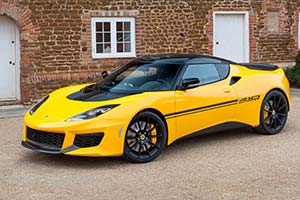
| Lotus Evora Sport 410 |
| Article | Image gallery (7) | Specifications |

|
|
Page 1 of 2 Next >> Following on from the recently announced Elise Cup 250, and the Exige Sport 350, Lotus' famous Lightweight Laboratory has been hard at work cutting the weight of the Evora 400 by a massive 70kg. With a host of high-performance carbon fibre components as standard, and sharing the 410 hp supercharged engine with the track-bred 3-Eleven, the Lotus Evora Sport 410 clocks 0-60 in 3.9 seconds on its way to a top speed of 186mph. Jean-Marc Gales, CEO of Group Lotus plc, commented, "We couldn't help ourselves, and many may have guessed what we were planning following our recent announcements. We wanted to make the Evora even better: lighter, faster and sharper, but our team has exceeded our expectations. Lotus has distilled what makes the Evora so special into something that's even more focused. The result is dynamically excellent and nothing short of superb." This new, top-of-the-range Evora has been thoroughly re-evaluated, with every component assessed, optimised and reengineered as required. This covers every aspect of the car, including a drastically simplified carbon fibre tailgate (combining five separate elements into one), new lighter-weight door trim panels and the liberal addition of carbon fibre across the entire car. The Sport 410 builds on the excellent work undertaken in the development of the Evora 400, itself a massive enhancement over the first generation of Evora. However, far from a stripped-out special, the Evora Sport 410 retains excellent road manners, being refined and composed during everyday driving. The significant drop in mass, and a power boost, means the Evora Sport 410 is capable of lapping the company's Hethel test track in 1 minute 28 seconds - an impressive 3 seconds faster than the Evora 400. Reflecting what Lotus does best, it demonstrates the company's principle of 'adding lightness'. The Lotus Evora Sport 410 is the result of Lotus' philosophy of continuous improvement. With a lower centre of gravity, and a kerb weight slashed to just 1,325 kg, the car provides an impressive 309 hp/tonne. In addition to boosting straight-line speed, the significant reduction in mass has allowed sharper, more agile and intuitive handling - with even greater accuracy and feel. Jean-Marc Gales added, "The Evora chassis was already the best in the business - the Evora Sport 410 takes it to a whole new level". Complementing this is a higher-output version of the supercharged, 3.5-litre 6-cylinder engine, developed through the Lotus 3-Eleven project which has beaten Nürburgring records. As a result, the car boasts 410 hp at 7000 rpm and 410 Nm of torque at 3500 rpm. The high-performance, carbon fibre components have played the single biggest role in the evolution of the Evora Sport 410. These include front splitter, roof panel, tailgate, and rear diffuser as well as race-derived sports seats and a revised front access panel. The one-piece carbon tailgate incorporates a louvered section, inspired by some of Lotus' most-famous heritage models, and together with carbon rear quarter-light panels help provide the car with a sleeker, fastback-style trailing roofline. These changes have also improved the car's aerodynamic downforce by 15% with no increase in drag. The car's reduced kerb weight has allowed the recalibration of the suspension, with improved geometry and completely revised damping, as well as a ride height 5mm lower than the Evora 400. As a result, handling is sharper, along with better body and roll control, yet ride comfort and composure is retained. Ultra light-weight, 10-spoke forged aluminium wheels, and optional Michelin Cup 2 tyres, complete the car's dynamic revisions. Page 1 of 2 Next >> |
| Article | Image gallery (7) | Specifications |
| All Cars - Contact us - Privacy Statement - Top | © 1998 - 2024 Ultimatecarpage.com |

